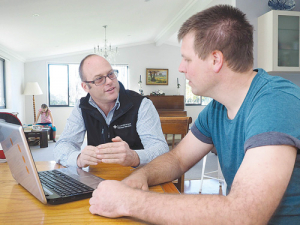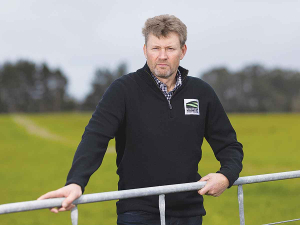Van Beek is 29% sharemilking on 155ha near Greytown, Wairarapa, and in a relatively short time has pushed the property into the top tier of six-week in-calf figures, achieving 75% last season over a 10-week mating span.
He came to the property five years ago when the reproductive performance was not looking good. “The six-week in-calf rate was around 57% and the empty rate was up at 24%.”
Those figures had earlier prompted farm owner James Smallwood to get into the DairyNZ InCalf programme, launched then by certified advisor Adrian Evans, of South Wairarapa Vets.
Evans says InCalf enabled him to sit down with farmer clients and realistically assess reproductive performance with set benchmarks. The 78% six-week in-calf target was a simple one and did not give any room to hide or disguise performance.
“And James was onboard as an early adopter,” says Evans.
The initial focus was on the ‘low hanging fruit’ that, once picked, can provide gains even within that season’s fertility performance.
That included boosting bull power post-artificial breeding (AB) and improving the staff’s ability to detect heats, through better training and attending DairyNZ heat detection workshops before the mating season started.
“After only a couple of seasons we had lifted the six-week figure to the mid-60s,” says Smallwood.
That coincided with van Beek taking over. He entered with some of the initial work done, but Evans says his task to improve reproduction outcomes even further was helped by having a boss who was “completely onboard” with the InCalf objectives.
After little success in synchronising part of the herd in his first season, van Beek decided to step back and look harder at what could be addressed.
“One thing not great was the young stock: they were coming in a bit light as first-calvers; body condition score (BCS) was not where it needed to be.”
He started to manage them more closely on the farm’s run-off. “That mainly involved feeding them better and putting essential minerals into them.” That included a copper bullet and a long-acting selenium dose in January as yearlings, and again before mating as rising two-year-olds, and a drench every four weeks.
“It’s made a big difference. We have a submission rate after their first calving of only one percent point lower than the herd, at 85-86% over three weeks, and empty rates comparable to the herd average of 12%.”
Herd BCS at drying off was also addressed.
“James was committed to dealing with the poor reproductive performance and the first year we came he dried the herd off earlier at 4.5 BCS and we got them to 5.0 BCS by the start of calving. He was prepared to sacrifice a decent level of production to achieve that, but he believed it was essential.”
Van Beek tuned up the allocation of the farm’s grass feed resources.
“They used to leave for the run-off on June 1; it would be mowed out then the herd would be back home, when you really wanted the platform to ramp up what grass growth it could and they would all be here at once.”
Now the herd is on the platform until well after June 1 and he has pushed the herd’s planned start of calving out to August 1, a big jump from July 15.
“It has made things a lot simpler. We can do an accurate spring rotation planner once the herd is off, to our September 13 balance date.”
While not necessarily delivering more production, that shift reduced the bought-in feed required with the earlier calving date.
“It’s stripped back, we use a bit of ProGibb. I think we could push it back to be more certain of making our 2600kg DM average cover for the start of calving.”
He believes copper and selenium supplied through the water line also help maintain herd health over the high stress post-calving period.
Drying off is also determined by a cow’s calving date, so later calvers with good BCS can expect to milk well into June.
The herd is now being fully fed post-calving at minimal cost, with the farm classed as a system three due to winter grazing on the run-off.
The staff are also well-versed in heat detection. The team attend a DairyNZ heat detection training day every year to get into the mating headspace; for Wilfred it is critical because the herd is milked through two separate dairies.
“Fortunately both my herd managers are very good, experienced operators. You need to know your staff have the ability to detect heats consistently; it is just too much pressure on you as the boss otherwise to maintain concentration over that length of time.”
Van Beek views his six-week in-calf success as an outcome of his overall focus on growing more grass all year round and matching supply to demand as close as possible, with a harvest of 16.5t DM/ha/year.
“There probably are farms with higher in-calf rates out there, but the challenge for me is to match that supply and demand, and achieve that high in-calf rate as efficiently as you can with pasture.”
Tactics for lifting herd reproduction stats
- Bull power – check the numbers of bulls against herd size for optimal ratio post-AB.
- Staff skills – ensure all staff involved in heat detection know what to look for.
- Young stock – don’t forget them, keep an eye on weight gains, BCS and health from weaning onwards.
- BCS at drying off – resist the urge to milk too long; focus on BCS 4.5 at drying off, as a minimum.
- Optimise planned start of calving date, to match grass growth to grass intake; minimise supplements required while still fully feeding the herd in the run up to mating.
- Take advantage of InCalf, a low cost, well-structured programme for lifting herd reproduction success with clear benchmarks. Visit dairynz.co.nz/incalf.
• This article was originally published in Inside Dairy, September 2016


















